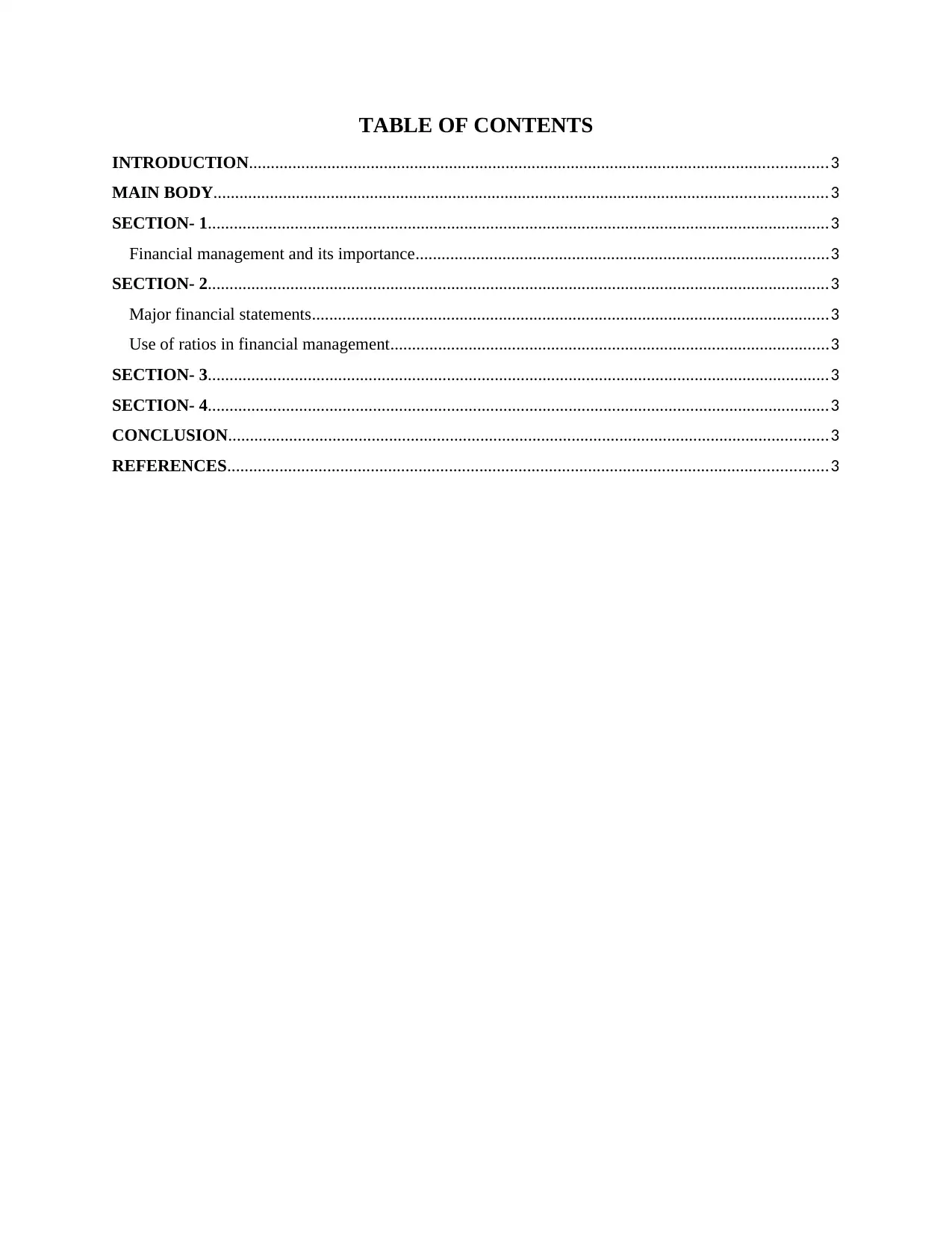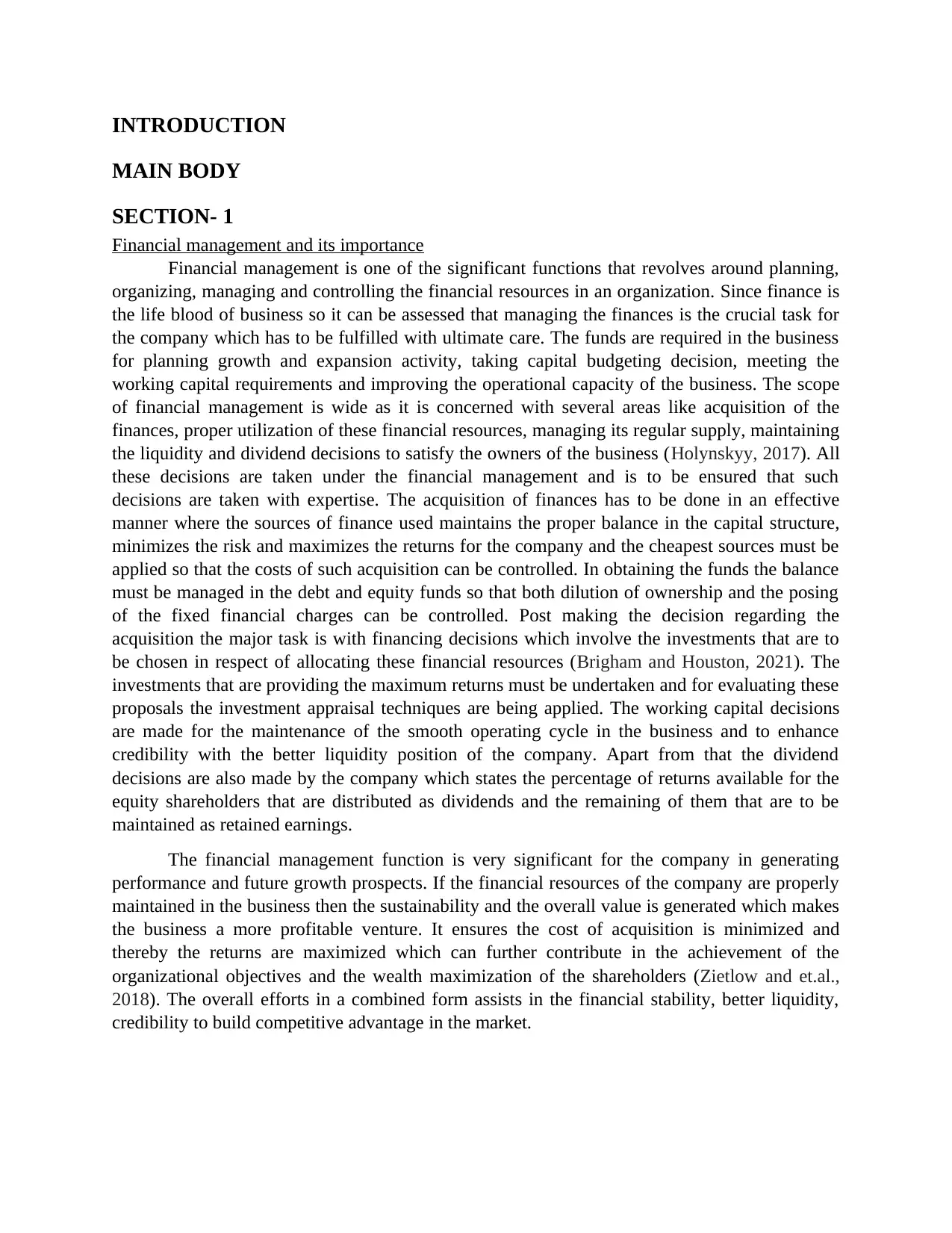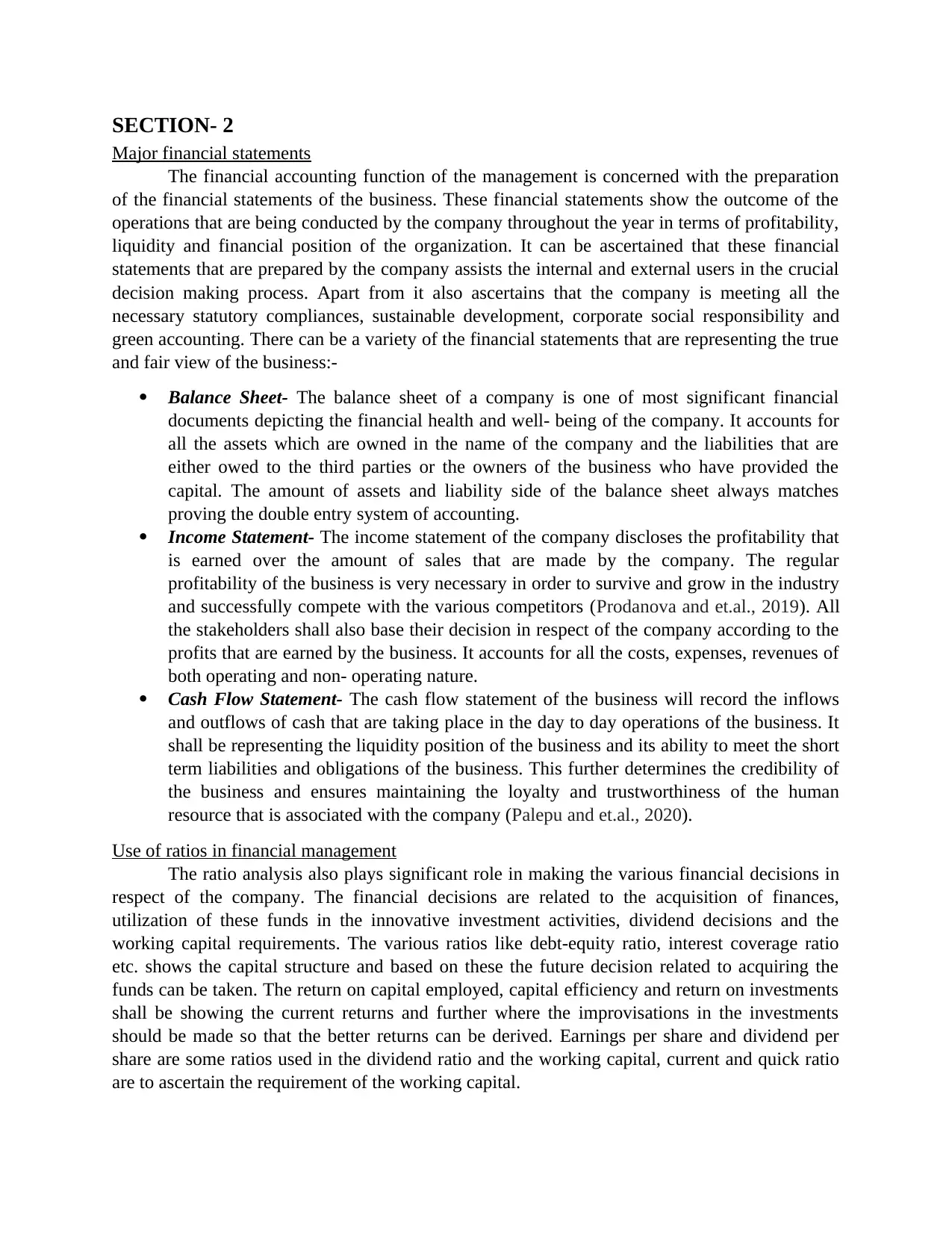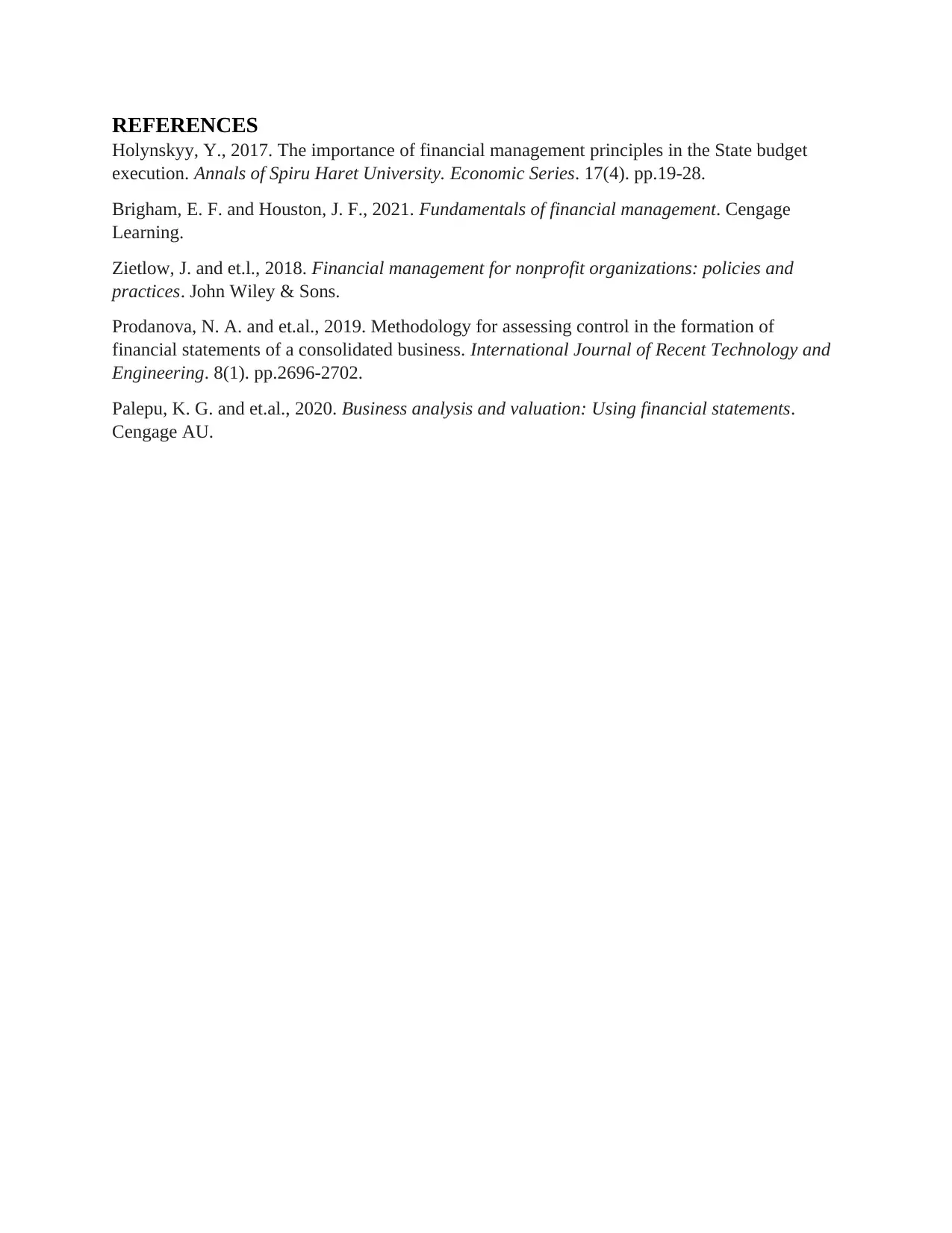Analysis of Financial Statements: Applied Business Finance 3005 Report
VerifiedAdded on 2022/12/14
|6
|1276
|450
Report
AI Summary
This report provides an overview of applied business finance, focusing on key aspects of financial management. It begins by defining financial management and highlighting its importance in planning, organizing, managing, and controlling financial resources within an organization, emphasizing its role in growth, expansion, and operational efficiency. The report then delves into major financial statements, including the balance sheet, income statement, and cash flow statement, explaining their significance in depicting a company's financial health, profitability, and liquidity. Furthermore, it examines the use of ratio analysis in financial decision-making, illustrating how ratios such as debt-equity, interest coverage, and return on capital employed are used to assess capital structure, investment performance, and working capital requirements. The report underscores the importance of these financial tools in achieving organizational objectives and maximizing shareholder wealth. The report also includes an introduction, conclusion, and a list of references.

3005 APPLIED BUSINESS
FINANCE
FINANCE
Paraphrase This Document
Need a fresh take? Get an instant paraphrase of this document with our AI Paraphraser

TABLE OF CONTENTS
INTRODUCTION.....................................................................................................................................3
MAIN BODY.............................................................................................................................................3
SECTION- 1...............................................................................................................................................3
Financial management and its importance...............................................................................................3
SECTION- 2...............................................................................................................................................3
Major financial statements.......................................................................................................................3
Use of ratios in financial management.....................................................................................................3
SECTION- 3...............................................................................................................................................3
SECTION- 4...............................................................................................................................................3
CONCLUSION..........................................................................................................................................3
REFERENCES..........................................................................................................................................3
INTRODUCTION.....................................................................................................................................3
MAIN BODY.............................................................................................................................................3
SECTION- 1...............................................................................................................................................3
Financial management and its importance...............................................................................................3
SECTION- 2...............................................................................................................................................3
Major financial statements.......................................................................................................................3
Use of ratios in financial management.....................................................................................................3
SECTION- 3...............................................................................................................................................3
SECTION- 4...............................................................................................................................................3
CONCLUSION..........................................................................................................................................3
REFERENCES..........................................................................................................................................3

INTRODUCTION
MAIN BODY
SECTION- 1
Financial management and its importance
Financial management is one of the significant functions that revolves around planning,
organizing, managing and controlling the financial resources in an organization. Since finance is
the life blood of business so it can be assessed that managing the finances is the crucial task for
the company which has to be fulfilled with ultimate care. The funds are required in the business
for planning growth and expansion activity, taking capital budgeting decision, meeting the
working capital requirements and improving the operational capacity of the business. The scope
of financial management is wide as it is concerned with several areas like acquisition of the
finances, proper utilization of these financial resources, managing its regular supply, maintaining
the liquidity and dividend decisions to satisfy the owners of the business (Holynskyy, 2017). All
these decisions are taken under the financial management and is to be ensured that such
decisions are taken with expertise. The acquisition of finances has to be done in an effective
manner where the sources of finance used maintains the proper balance in the capital structure,
minimizes the risk and maximizes the returns for the company and the cheapest sources must be
applied so that the costs of such acquisition can be controlled. In obtaining the funds the balance
must be managed in the debt and equity funds so that both dilution of ownership and the posing
of the fixed financial charges can be controlled. Post making the decision regarding the
acquisition the major task is with financing decisions which involve the investments that are to
be chosen in respect of allocating these financial resources (Brigham and Houston, 2021). The
investments that are providing the maximum returns must be undertaken and for evaluating these
proposals the investment appraisal techniques are being applied. The working capital decisions
are made for the maintenance of the smooth operating cycle in the business and to enhance
credibility with the better liquidity position of the company. Apart from that the dividend
decisions are also made by the company which states the percentage of returns available for the
equity shareholders that are distributed as dividends and the remaining of them that are to be
maintained as retained earnings.
The financial management function is very significant for the company in generating
performance and future growth prospects. If the financial resources of the company are properly
maintained in the business then the sustainability and the overall value is generated which makes
the business a more profitable venture. It ensures the cost of acquisition is minimized and
thereby the returns are maximized which can further contribute in the achievement of the
organizational objectives and the wealth maximization of the shareholders (Zietlow and et.al.,
2018). The overall efforts in a combined form assists in the financial stability, better liquidity,
credibility to build competitive advantage in the market.
MAIN BODY
SECTION- 1
Financial management and its importance
Financial management is one of the significant functions that revolves around planning,
organizing, managing and controlling the financial resources in an organization. Since finance is
the life blood of business so it can be assessed that managing the finances is the crucial task for
the company which has to be fulfilled with ultimate care. The funds are required in the business
for planning growth and expansion activity, taking capital budgeting decision, meeting the
working capital requirements and improving the operational capacity of the business. The scope
of financial management is wide as it is concerned with several areas like acquisition of the
finances, proper utilization of these financial resources, managing its regular supply, maintaining
the liquidity and dividend decisions to satisfy the owners of the business (Holynskyy, 2017). All
these decisions are taken under the financial management and is to be ensured that such
decisions are taken with expertise. The acquisition of finances has to be done in an effective
manner where the sources of finance used maintains the proper balance in the capital structure,
minimizes the risk and maximizes the returns for the company and the cheapest sources must be
applied so that the costs of such acquisition can be controlled. In obtaining the funds the balance
must be managed in the debt and equity funds so that both dilution of ownership and the posing
of the fixed financial charges can be controlled. Post making the decision regarding the
acquisition the major task is with financing decisions which involve the investments that are to
be chosen in respect of allocating these financial resources (Brigham and Houston, 2021). The
investments that are providing the maximum returns must be undertaken and for evaluating these
proposals the investment appraisal techniques are being applied. The working capital decisions
are made for the maintenance of the smooth operating cycle in the business and to enhance
credibility with the better liquidity position of the company. Apart from that the dividend
decisions are also made by the company which states the percentage of returns available for the
equity shareholders that are distributed as dividends and the remaining of them that are to be
maintained as retained earnings.
The financial management function is very significant for the company in generating
performance and future growth prospects. If the financial resources of the company are properly
maintained in the business then the sustainability and the overall value is generated which makes
the business a more profitable venture. It ensures the cost of acquisition is minimized and
thereby the returns are maximized which can further contribute in the achievement of the
organizational objectives and the wealth maximization of the shareholders (Zietlow and et.al.,
2018). The overall efforts in a combined form assists in the financial stability, better liquidity,
credibility to build competitive advantage in the market.
⊘ This is a preview!⊘
Do you want full access?
Subscribe today to unlock all pages.

Trusted by 1+ million students worldwide

SECTION- 2
Major financial statements
The financial accounting function of the management is concerned with the preparation
of the financial statements of the business. These financial statements show the outcome of the
operations that are being conducted by the company throughout the year in terms of profitability,
liquidity and financial position of the organization. It can be ascertained that these financial
statements that are prepared by the company assists the internal and external users in the crucial
decision making process. Apart from it also ascertains that the company is meeting all the
necessary statutory compliances, sustainable development, corporate social responsibility and
green accounting. There can be a variety of the financial statements that are representing the true
and fair view of the business:-
Balance Sheet- The balance sheet of a company is one of most significant financial
documents depicting the financial health and well- being of the company. It accounts for
all the assets which are owned in the name of the company and the liabilities that are
either owed to the third parties or the owners of the business who have provided the
capital. The amount of assets and liability side of the balance sheet always matches
proving the double entry system of accounting.
Income Statement- The income statement of the company discloses the profitability that
is earned over the amount of sales that are made by the company. The regular
profitability of the business is very necessary in order to survive and grow in the industry
and successfully compete with the various competitors (Prodanova and et.al., 2019). All
the stakeholders shall also base their decision in respect of the company according to the
profits that are earned by the business. It accounts for all the costs, expenses, revenues of
both operating and non- operating nature.
Cash Flow Statement- The cash flow statement of the business will record the inflows
and outflows of cash that are taking place in the day to day operations of the business. It
shall be representing the liquidity position of the business and its ability to meet the short
term liabilities and obligations of the business. This further determines the credibility of
the business and ensures maintaining the loyalty and trustworthiness of the human
resource that is associated with the company (Palepu and et.al., 2020).
Use of ratios in financial management
The ratio analysis also plays significant role in making the various financial decisions in
respect of the company. The financial decisions are related to the acquisition of finances,
utilization of these funds in the innovative investment activities, dividend decisions and the
working capital requirements. The various ratios like debt-equity ratio, interest coverage ratio
etc. shows the capital structure and based on these the future decision related to acquiring the
funds can be taken. The return on capital employed, capital efficiency and return on investments
shall be showing the current returns and further where the improvisations in the investments
should be made so that the better returns can be derived. Earnings per share and dividend per
share are some ratios used in the dividend ratio and the working capital, current and quick ratio
are to ascertain the requirement of the working capital.
Major financial statements
The financial accounting function of the management is concerned with the preparation
of the financial statements of the business. These financial statements show the outcome of the
operations that are being conducted by the company throughout the year in terms of profitability,
liquidity and financial position of the organization. It can be ascertained that these financial
statements that are prepared by the company assists the internal and external users in the crucial
decision making process. Apart from it also ascertains that the company is meeting all the
necessary statutory compliances, sustainable development, corporate social responsibility and
green accounting. There can be a variety of the financial statements that are representing the true
and fair view of the business:-
Balance Sheet- The balance sheet of a company is one of most significant financial
documents depicting the financial health and well- being of the company. It accounts for
all the assets which are owned in the name of the company and the liabilities that are
either owed to the third parties or the owners of the business who have provided the
capital. The amount of assets and liability side of the balance sheet always matches
proving the double entry system of accounting.
Income Statement- The income statement of the company discloses the profitability that
is earned over the amount of sales that are made by the company. The regular
profitability of the business is very necessary in order to survive and grow in the industry
and successfully compete with the various competitors (Prodanova and et.al., 2019). All
the stakeholders shall also base their decision in respect of the company according to the
profits that are earned by the business. It accounts for all the costs, expenses, revenues of
both operating and non- operating nature.
Cash Flow Statement- The cash flow statement of the business will record the inflows
and outflows of cash that are taking place in the day to day operations of the business. It
shall be representing the liquidity position of the business and its ability to meet the short
term liabilities and obligations of the business. This further determines the credibility of
the business and ensures maintaining the loyalty and trustworthiness of the human
resource that is associated with the company (Palepu and et.al., 2020).
Use of ratios in financial management
The ratio analysis also plays significant role in making the various financial decisions in
respect of the company. The financial decisions are related to the acquisition of finances,
utilization of these funds in the innovative investment activities, dividend decisions and the
working capital requirements. The various ratios like debt-equity ratio, interest coverage ratio
etc. shows the capital structure and based on these the future decision related to acquiring the
funds can be taken. The return on capital employed, capital efficiency and return on investments
shall be showing the current returns and further where the improvisations in the investments
should be made so that the better returns can be derived. Earnings per share and dividend per
share are some ratios used in the dividend ratio and the working capital, current and quick ratio
are to ascertain the requirement of the working capital.
Paraphrase This Document
Need a fresh take? Get an instant paraphrase of this document with our AI Paraphraser

SECTION- 3
SECTION- 4
CONCLUSION
SECTION- 4
CONCLUSION

REFERENCES
Holynskyy, Y., 2017. The importance of financial management principles in the State budget
execution. Annals of Spiru Haret University. Economic Series. 17(4). pp.19-28.
Brigham, E. F. and Houston, J. F., 2021. Fundamentals of financial management. Cengage
Learning.
Zietlow, J. and et.l., 2018. Financial management for nonprofit organizations: policies and
practices. John Wiley & Sons.
Prodanova, N. A. and et.al., 2019. Methodology for assessing control in the formation of
financial statements of a consolidated business. International Journal of Recent Technology and
Engineering. 8(1). pp.2696-2702.
Palepu, K. G. and et.al., 2020. Business analysis and valuation: Using financial statements.
Cengage AU.
Holynskyy, Y., 2017. The importance of financial management principles in the State budget
execution. Annals of Spiru Haret University. Economic Series. 17(4). pp.19-28.
Brigham, E. F. and Houston, J. F., 2021. Fundamentals of financial management. Cengage
Learning.
Zietlow, J. and et.l., 2018. Financial management for nonprofit organizations: policies and
practices. John Wiley & Sons.
Prodanova, N. A. and et.al., 2019. Methodology for assessing control in the formation of
financial statements of a consolidated business. International Journal of Recent Technology and
Engineering. 8(1). pp.2696-2702.
Palepu, K. G. and et.al., 2020. Business analysis and valuation: Using financial statements.
Cengage AU.
⊘ This is a preview!⊘
Do you want full access?
Subscribe today to unlock all pages.

Trusted by 1+ million students worldwide
1 out of 6
Related Documents
Your All-in-One AI-Powered Toolkit for Academic Success.
+13062052269
info@desklib.com
Available 24*7 on WhatsApp / Email
![[object Object]](/_next/static/media/star-bottom.7253800d.svg)
Unlock your academic potential
Copyright © 2020–2025 A2Z Services. All Rights Reserved. Developed and managed by ZUCOL.




